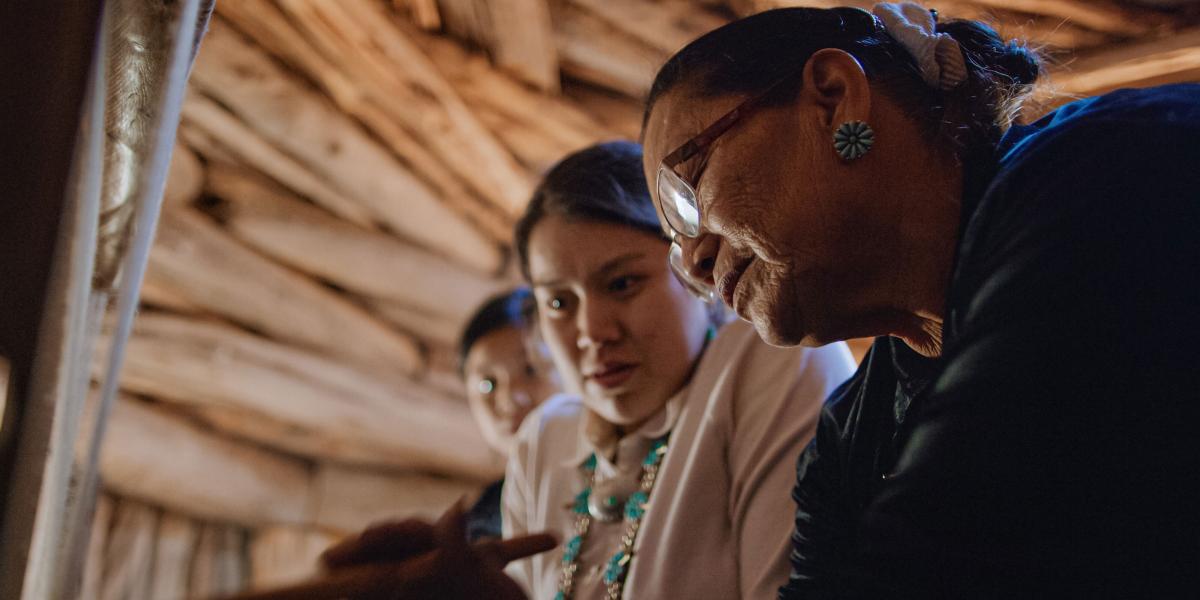Uplifting Indigenous Voices
The health threats facing Native communities call for culturally grounded solutions.
As the sun nestles into the Klamath mountains of Northern California, my parents, partner, and I make our way through the willow brush on Tishawnik flat. My mother, a prolific Karuk basketweaver, shows me how to prune the willow, ensuring its optimal growth. In exchange, we accept its gift of sticks, destined to become spines of elegant baskets.
The principle of reciprocity is central to Karuk teachings and resonant in many Indigenous cultures. In the Karuk worldview, success in life is not so much defined by academic achievement but by how you serve your community, the land, and the generations to come.
A similar community-oriented focus drives many of my Indigenous colleagues at Hopkins.
"What I am learning in the classroom and through my research is bringing me closer to improving the health for my people and my community," says Tara Maudrie (Sault Ste Marie Nation of Chippewa Indians), an MSPH candidate at the Bloomberg School.
In Indigenous communities, culturally grounded and holistic approaches to health and well-being precede the inception of the field of public health. “The words ‘public health’ are a Western concept, but my parents were the first public health practitioners I knew,” says Abigail Echo-Hawk of the Pawnee Tribe, director of the Seattle Urban Indian Health Board, in Crosscut magazine.
Nonetheless, centuries of colonialism, forced assimilation, and genocide have disrupted many practices that once made Native Americans some of the healthiest people on the planet. Throughout Indian Country, there is a flourishing effort to return to our languages, worldviews, and traditions.
Yet, staggering health inequities persist. Today, 25% of Native Americans don't live to celebrate their 45th birthday. Among all racial and ethnic groups, they have the highest rates of diabetes, youth suicide, and violent victimization. Native Americans have been disproportionately affected by the COVID-19 pandemic, losing beloved community members and Elders—and with them, connections to history, culture, language, and ancestral knowledge.
The U.S. government, constitutionally obligated to ensure health and education for Indigenous peoples, has broken its promise to Tribal Nations time and time again. Centuries of failed colonial approaches to health care for Native peoples demonstrate that real solutions need to come from within our communities. But Native representation in academic public health and Western medicine remains abysmal. According to the American Medical Association, just 0.4% of the physician workforce is Native. At the Bloomberg School, the country’s top-ranked and largest school of public health, a meager 0.29% of students report being American Indian or Alaska Native.
As an MPH student (class of 2020), I too experienced the isolation that came with being one of only two Native students on the Bloomberg School’s East Baltimore campus. Moreover, Indigenous issues and Indigenous solutions were glaringly underrepresented from coursework and general discourse, to the detriment of quality in education and further contributing to the erasure of Indigenous peoples in present-day settler-colonial society.
Native peoples, the traditional stewards of the lands, hold knowledge and understandings fundamental to solving many of the most pertinent population health threats.
Back on Tishawnik flat, my dad and partner discuss which areas of the flat need "Good Fire." Low-intensity, prescribed burns are a Karuk land-management practice as old as time. They protect people, plants, and animals from catastrophic wildfires, ensure a good acorn season, and help the willow grow straight and tall—the way we like our basketweaving materials.
Not long ago, federal policies prohibited this cultural practice. Karuk people are now leading the eco-cultural revitalization of traditional burning, and Western science is finally catching up. Native peoples, the traditional stewards of the lands, hold knowledge and understandings fundamental to solving many of the most pertinent population health threats.
As the inaugural Mathuram Santosham Chair in Native American Health at the Bloomberg School, Victoria O’Keefe, PhD, (Cherokee and Seminole Nations) is harnessing the cultural strengths of Native communities in prevention programs to reduce health disparities among Indigenous peoples. A children's storybook—Our Smallest Warriors, Our Strongest Medicine: Overcoming COVID-19—which O'Keefe and her colleagues developed with an intertribal workgroup, is a pertinent example.
"We bring our tribally diverse worldviews, values, and voices to public health and academic settings,” says O’Keefe, the School’s first Native American tenure-track professor. “Collectively, our presence in these spaces shows that we're still here and can share important lessons about living relationally to be well."
To advance health and well-being for all people, the School’s community must uplift Indigenous voices and perspectives and take meaningful steps toward reconciliation.
